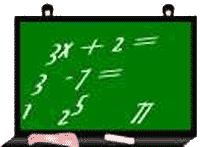Math Tips
Here are some “how-to’s” that will come in handy.
How to Round a Number
To the nearest ten
If the ones digit is 5 or more, round to the next highest ten (68 rounds to 70).
If the ones digit is less than 5, round to the next lowest ten (33 rounds to 30).
 To the nearest hundred
To the nearest hundred
If the tens digit is 5 or more, round to the next highest hundred (384 rounds to 400).
If the tens digit is less than 5, round to the next lowest hundred (427 rounds to 400).
To the nearest thousand
If the hundreds digit is 5 or more, round to the next highest thousand (7,602 rounds to 8,000).
If the hundreds digit is less than 5, round to the next lowest thousand (7,268 rounds to 7,000).
How to Find an Average
To find the average of several numbers, add the numbers together and then divide the sum by the number of numbers.
The average of 17, 30, 6, and 7 = 60 ÷ 4 = 15
How to Tell if Two Fractions are Equivalent
Cross multiply the fractions. If both products are the same, the fractions are equivalent.
3 and 9 3 x 24 = 72 3 and 9 are equivalent fractions.
8 24 8 x 9 = 72 8 24
5 and 3 5 x12 = 60 5 and 3 are not equivalent fractions.
8 12 8 x 3 = 24 8 12
 How to Find a Percentage
How to Find a Percentage
To tell what percentage one number is of a second number, divide the first number by the second. Move the decimal point of the resulting quotient two places to the right.
Example: What percentage is 20 of 300?
20 ÷ 300 = .067 = 6.7%
How to Change a Fraction to a Percentage
Divide the numerator by the denominator. Move the decimal point of the resulting quotient two places to the right.
6 = 6 ÷ 15 = .4 = .40 = 40%
15
How to Change a Decimal to a Percentage
Move the decimal point two places to the right.
0.792 = 79.2%
Refer to these how-to’s until you can do them automatically.
